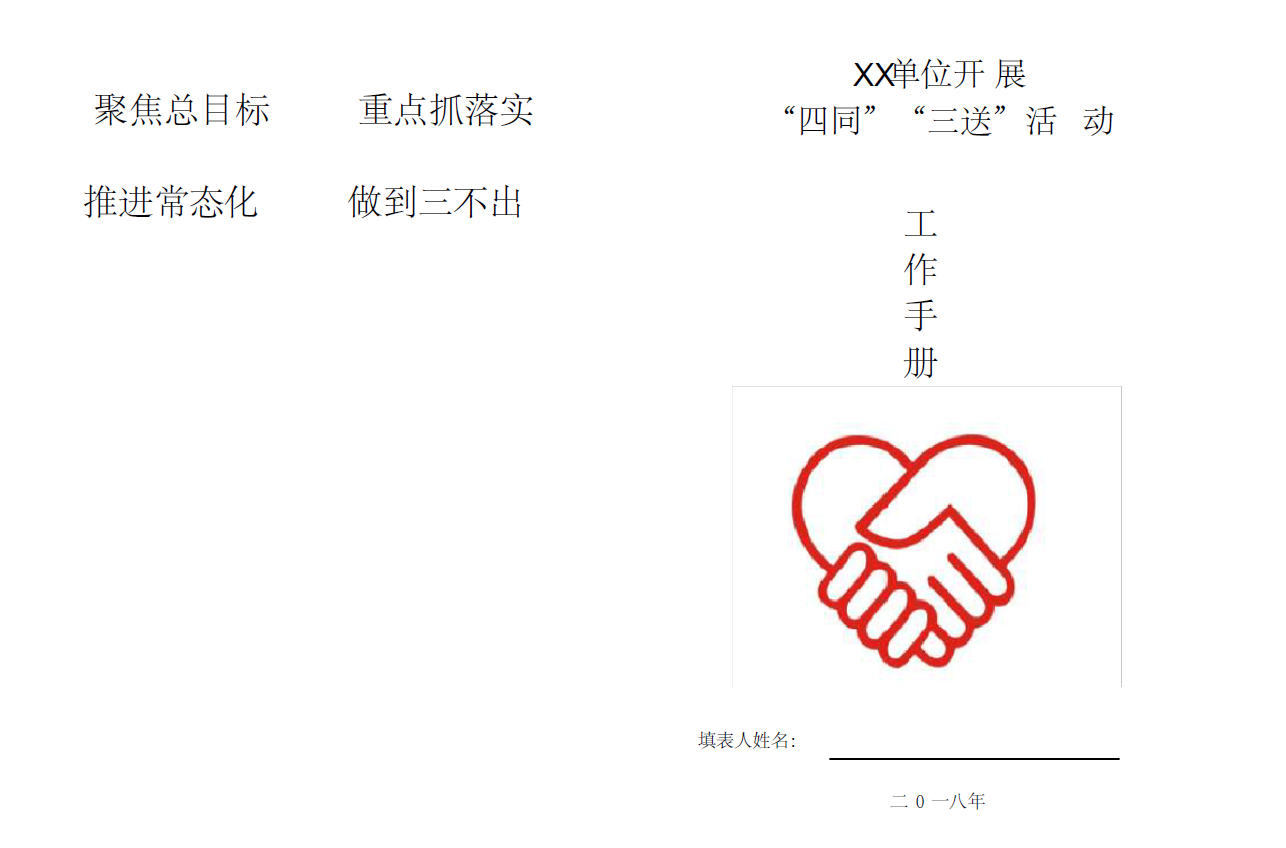
Figure 1: The handbook’s title page. The four phrases on the left are “focus on the overall goal; emphasize implementation; promote normalization; achieve the ‘three nos'” (聚焦总目标; 重点抓落实; 推进常态化; 做到三不出). The right side features the handbook’s title, “The ‘Four Togethers’ and ‘Three Gifts’ Campaign Handbook,” as well as a space for the campaign worker’s name.
This handbook contains instructions for campaign workers as they visited households to carry out “Four Togethers and Four Gifts” (四同四送 si tong si song) activities. Beginning sometime after 2014, when the fanghuiju campaign (访惠聚) was first implemented, these activities blended poverty alleviation work with knowledge dissemination and state surveillance. Cadres and other civil servants were assigned Uyghur or Kazakh “relatives”—usually family members of recent detainees—and lived, dined, and worked with them for extended periods. As this handbook shows, the activities initially featured just three “gifts”: law, policy, and warmth. Blogs produced by those carrying out this work used the “Four Togethers and Three Gifts” formulation until at least February 2018. Yet, by the October 2018 publication of this People’s Daily article, the inclusion of the gift of “civilization” (文明) had transformed the policy into the “Four Togethers and Four Gifts” (see the Glossary, Cadre Blogs, and the “Becoming Family” Handbooks for more information on this interconnected mass work). Darren Byler’s article for ChinaFile summarizes the contents of this particular handbook, which was used in Kashgar:
relatives were given specific instructions on how to get their “relatives” to “let down their guard.” The manual, which was posted on the Internet but taken down just as this story was going to press, advised “relatives” to show “warmth.” “Don’t lecture right away” it suggested, and show concern regarding their families and bring candy for the children. It provided a checklist that included questions such as: “When entering the household, do family members appear flustered and use evasive language? Do they not watch TV programs at home, and instead only watch VCD discs? Are there any religious items still hanging on the walls of the house?”
The manual instructs the relatives to tell their “little brothers and sisters” that they have been monitoring all Internet and cell phone communication that is coming from the family, so they should not even think about lying when it comes to their knowledge of Islam and religious extremism.
The manual also instructed them to help the villagers alleviate their poverty by giving them business advice and helping out around the household. They were told to report any resistance to “poverty-alleviation activities.”
According to Byler, the handbook was originally uploaded by a low-ranking cadre named Kahar. Materials on Baidu confirmed that Kahar was a member of the education department in Poskam County, Kashgar Prefecture, but they have since disappeared. The handbook was also reposted here. These origins make assessing the widespread usage of the handbook challenging, but reports from Kashgar, Aksu, Bayingol, and Altay Prefectures demonstrate that state representatives were using the workbook and implementing the “Four Togethers and Four Gifts” throughout the region. The handbook was likely in use wherever campaign activities took place.

Figure 2: “Bünyazhan Osman is the mother of two children. Her husband is receiving education because of his participation in illegal religious activities. On one hand, she must care for her elderly mother-in-law and children, and on the other hand, she must single-handedly support the entire family.” The “Four Togethers and Four Gifts” activities typically included asking about the lives of Xinjiang’s ethnic minority families, many of whom had been immiserated by the detention of working relatives (《有了党的好政策,日子一定会越过越好!张国华走访入户访民情》).
The manual also contains a detailed section instructing campaign workers on how to explain phone surveillance: Those who make contact with people outside China or use a VPN to access religious content will find their phone services suspended. Campaign workers are responsible for informing their “relatives” that changing phones or phone numbers is useless, and that Operation 9.13, a surveillance campaign, has already impacted over 100,000 people. A Human Rights Watch report on the Integrated Joint Operations Platform (一体化联合作战平台), a system that collects mass surveillance data, notes that Operation 9.13 provides authorities access to information about a people suspected of accessing “problematic” content and software, including their “phone’s unique identifier (IMEI number), base station information that can be used to track the movement of the phone user, where this person can generally be found, and whether the person has removed ‘unlawful software’ from the phone.”
The manual repeatedly emphasizes the futility of evading this kind of surveillance: “We have all the details we can trace. In what month, on what day you called whom, at what time, for how long—all information is in our hands” (我们有轨迹可查,你哪一月、哪一天和谁在什么时间,打了几分钟电话,我们都掌握的清清楚楚). It also clarifies what sorts of actions lead to detention. In addition to those who watch content deemed to be of a terrorist nature, anyone who fails to report themselves to the police, cannot explain their actions, or is deemed “problematic” is targeted. Those who are reluctant to provide information are judged to be especially dangerous: “The more one conceals, the more guilt they have inside, and the more problematic they are” (越隐瞒就越说明心理有鬼、越有问题). The manual concludes the section with an explanation of the value of these policies to national security and personal safety. Echoing the expectations of gratitude found in many official texts describing these activities, the section concludes: “Should they not be grateful to the Party?” (是不是应该感谢党?). The handbook, as well as a translation of the manual’s description of phone surveillance policies, are both available below:
Translation of “Clarify ‘Operation 9.13’ Crime-related Questions”:
The “Four Togethers and Four Gifts” (四同四送 si tong si song) Handbook: